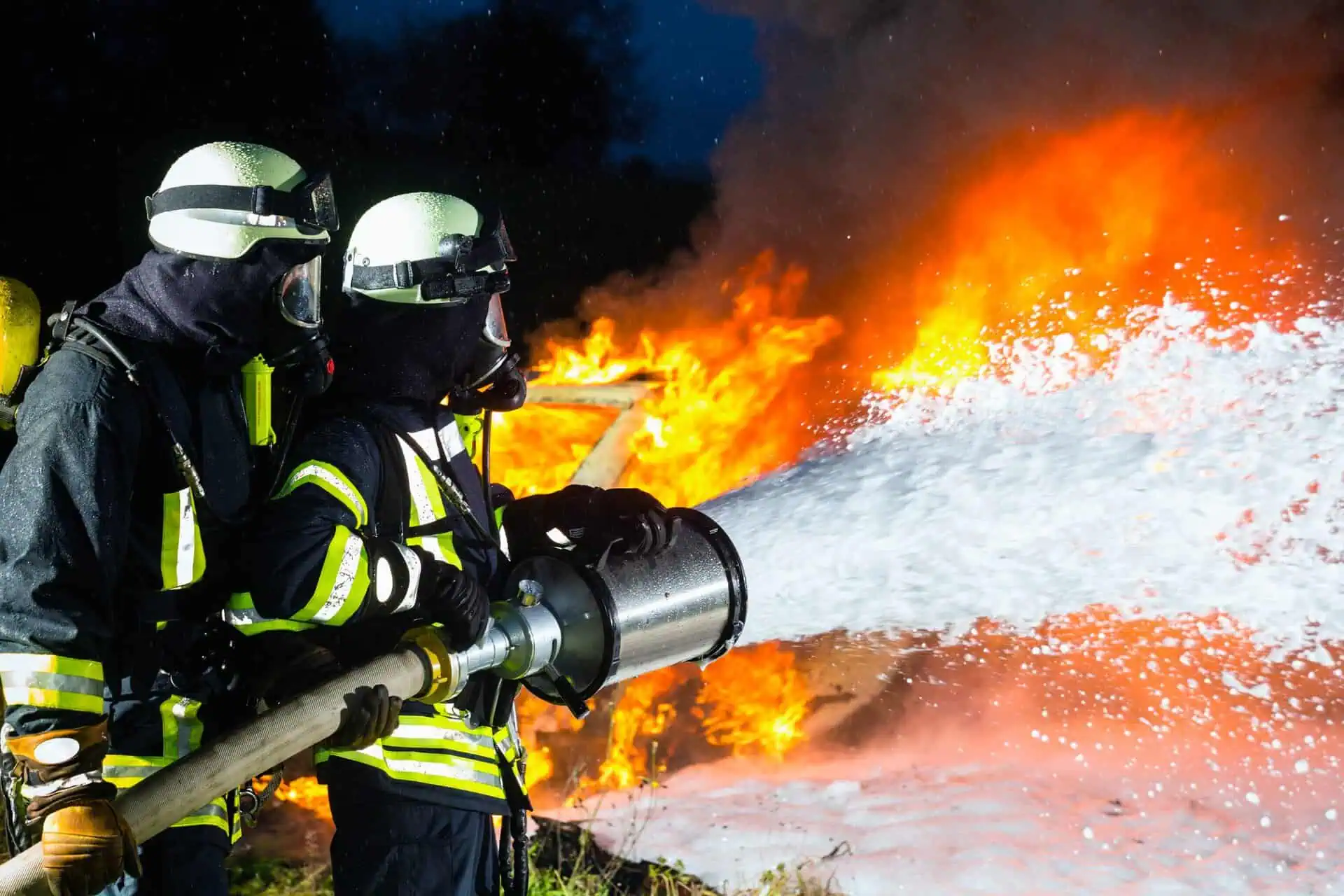AFFF Thyroid Cancer Lawsuit
- Last Updated: July 14th, 2025

Attorney Jessica Paluch-Hoerman, founder of TruLaw, has over 28 years of experience as a personal injury and mass tort attorney, and previously worked as an international tax attorney at Deloitte. Jessie collaborates with attorneys nationwide — enabling her to share reliable, up-to-date legal information with our readers.
Legally Reviewed
This article has been written and reviewed for legal accuracy and clarity by the team of writers and legal experts at TruLaw and is as accurate as possible. This content should not be taken as legal advice from an attorney. If you would like to learn more about our owner and experienced injury lawyer, Jessie Paluch, you can do so here.
Fact-Checked
TruLaw does everything possible to make sure the information in this article is up to date and accurate. If you need specific legal advice about your case, contact us by using the chat on the bottom of this page. This article should not be taken as advice from an attorney.
Key takeaways:
- Toxic chemicals in AFFF firefighting foam, particularly PFAS, are linked to a higher risk of thyroid cancer, especially among firefighters and military personnel.
- Victims affected by thyroid cancer due to AF exposure are filing lawsuits for compensation, covering medical costs, lost wages, and emotional trauma.
- Establishing causation in these lawsuits requires detailed evidence, such as medical records and expert testimony linking PFAS exposure to the development of thyroid cancer.
Overview of the AFFF Thyroid Cancer Lawsuit
On this page, we’ll provide an overview of the AFFF Thyroid Cancer Lawsuit, estimates for possible AFFF Lawsuit settlement amounts, eligibility criteria to file an AFFF Lawsuit, and much more.
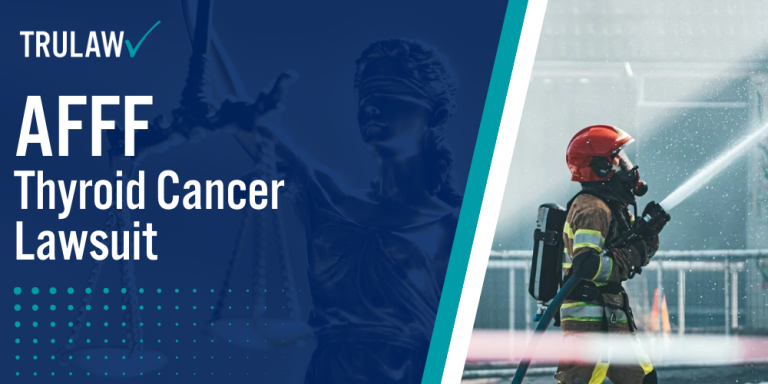
What are the AFFF Thyroid Cancer Lawsuits?
Aqueous Film Forming Foam (AFFF) has been used for decades to fight fires involving Class B materials like jet fuel, oil, and gas.
However, many of these foams contain PFAS chemicals (commonly referred to as “forever chemicals”).
These PFAS chemicals have been associated with serious health risks — a few of which include developing thyroid cancer, thyroid disease, or various other forms of cancer.
Individuals across the country are filing AFFF firefighting foam lawsuits after being exposed to these toxic chemicals and subsequently suffering health issues.
While the use of AFFF has been reduced, countless individuals continue to deal with health effects potentially linked to their past exposure.
If you or a loved one has been diagnosed with thyroid cancer, other cancers, or related health issues, you may be eligible to file an AFFF firefighting foam lawsuit.
The experienced AFFF lawyers at TruLaw and our partner law firms work tirelessly to ensure individuals affected by AFFF exposure have access to the legal support they need.
Use the chatbot on this page to instantly determine if you qualify for an AFFF lawsuit.
Our team is here to assist with any questions and help guide you through the next steps.
If you suspect AFFF exposure has impacted your health, don’t hesitate to reach out for more information.
Table of Contents
The Risk of Thyroid Cancer Linked to AFFF Firefighting Foam Exposure
As the number of toxic firefighting foam lawsuits continues to grow, research studies increasingly reveal the harmful effects of AFFF exposure.
Thyroid cancer, in particular, has been linked to PFAS chemicals found in AFFF.
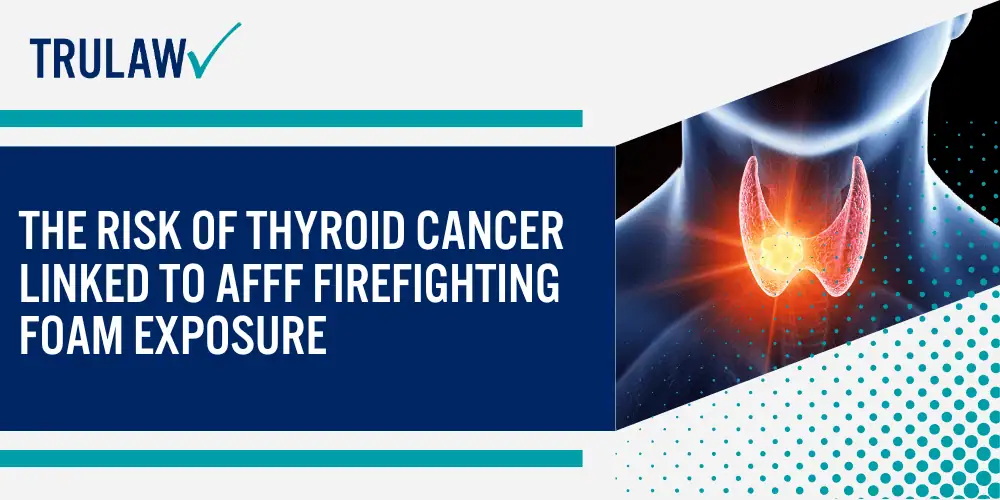
Located in the neck, the thyroid gland is crucial for regulating metabolic processes by producing hormones such as thyroxine (T4) and triiodothyronine (T3).
Thyroid cancer can develop when cells within the thyroid gland undergo abnormal changes and begin to grow uncontrollably, potentially spreading to other areas of the body.
If you or a loved one were exposed to AFFF and later diagnosed with thyroid cancer or another illness, you may be eligible to file an AFFF lawsuit.
Use the chatbot on this page to see if you qualify, or contact us for more information.
Impact of PFAS Chemicals in Firefighting Foam on Human Health
For years, manufacturers and organizations like the U.S. Navy, which first approved AFFF, were aware of its toxic effects.
Research has demonstrated links between PFAS exposure and increased risks for various cancers and other health issues.
A number of scientific studies have confirmed the dangers of PFAS chemicals, leading to widespread concern over their health impacts, particularly for individuals like civilian and military firefighters, chemical plant workers, and those involved in the transport and production of firefighting foam.
Studies on AFFF exposure and health risks include:
- The U.S. Environmental Protection Agency (EPA) issued health advisories for PFOA and PFOS, noting that long-term exposure could pose health risks.
- The International Agency for Research on Cancer (IARC) classified PFOA as possibly carcinogenic to humans.
- A Journal of the American Medical Association study found an association between PFOA exposure and increased risks of kidney cancer, testicular cancer, and ulcerative colitis.
- A study in the International Journal of Cancer reported a link between PFOS exposure and breast cancer.
- Researchers at the National Research Centre for Environmental Toxicology (Australia) found elevated fluorinated surfactants in firefighters’ bloodstreams.
- A University of California, Berkeley study found women firefighters who used AFFF had higher levels of PFAS compared to their counterparts.
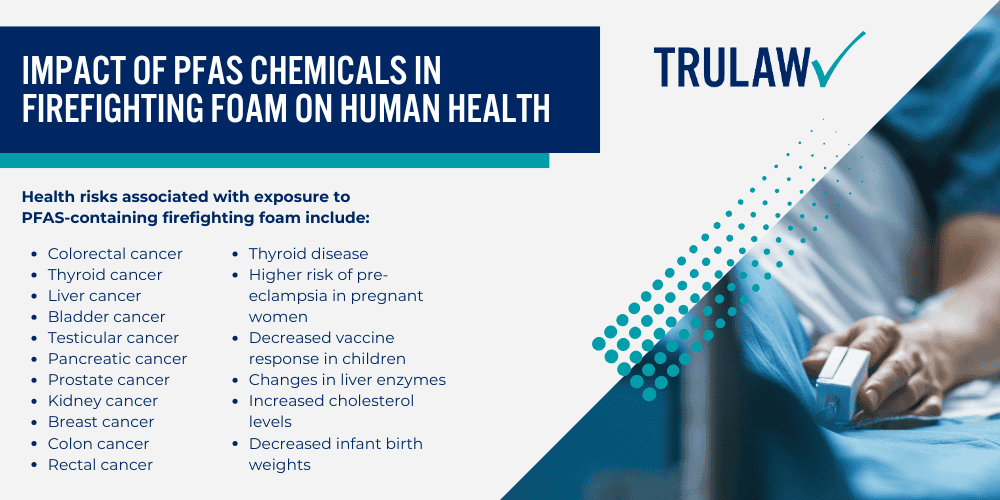
Health risks associated with exposure to PFAS-containing firefighting foam include:
- Colorectal cancer
- Thyroid cancer
- Liver cancer
- Bladder cancer
- Testicular cancer
- Pancreatic cancer
- Prostate cancer
- Kidney cancer
- Breast cancer
- Colon cancer
- Rectal cancer
- Thyroid disease
- Higher risk of pre-eclampsia in pregnant women
- Decreased vaccine response in children
- Changes in liver enzymes
- Increased cholesterol levels
- Decreased infant birth weights
These studies underscore the importance of ongoing research and legal action to address the harm caused by AFFF exposure.
AFFF Firefighting Foam Lawsuit Explained
The AFFF Lawsuit refers to legal actions brought by individuals who have experienced adverse health outcomes due to exposure to AFFF firefighting foam products containing PFAS chemicals.
PFAS, often called “forever chemicals,” are known for their persistence in both the environment and the human body, and have been linked to various health issues, including cancer.
Numerous individuals exposed to AFFF firefighting foam, whether through military service, occupational settings, or other forms of contact, have later been diagnosed with cancer or other severe health conditions.
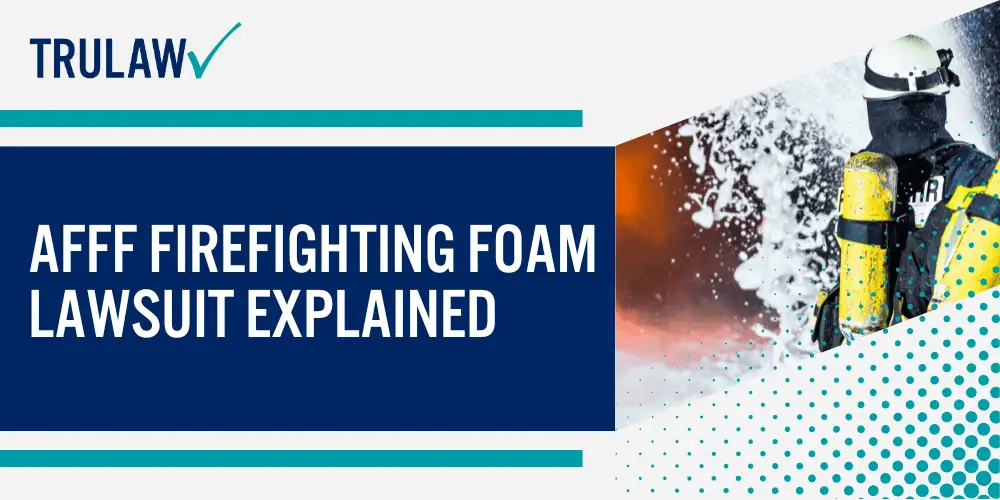
Due to the large number of AFFF lawsuits filed against manufacturers, the AFFF firefighting foam cases have been consolidated into an AFFF multidistrict litigation (MDL) to streamline the process.
The AFFF MDL is centralized in the US District Court for the District of South Carolina, where it helps manage the growing number of AFFF foam lawsuits.
Defendants in the AFFF Firefighting Foam Litigation
The defendants in these AFFF lawsuits are primarily the manufacturers of AFFF firefighting foam.
These companies are accused of producing and selling products containing PFAS chemicals, which are linked to serious health risks.
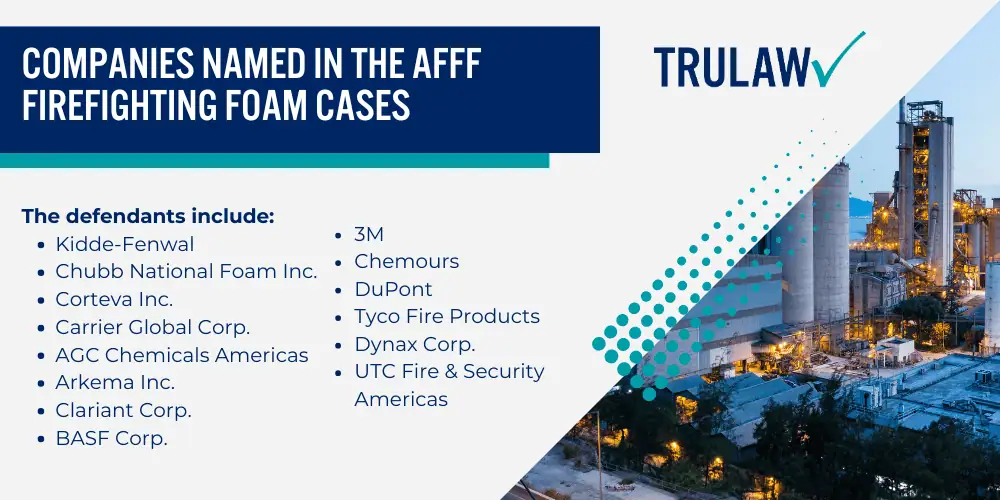
Defendants in the AFFF Lawsuit include:
- Kidde-Fenwal
- Chubb National Foam Inc.
- Corteva Inc.
- Carrier Global Corp.
- AGC Chemicals Americas
- Arkema Inc.
- Clariant Corp.
- BASF Corp.
- 3M
- Chemours
- DuPont
- Tyco Fire Products
- Dynax Corp.
- UTC Fire & Security Americas
Estimated Settlement Amounts in AFFF Lawsuits
While no settlements have yet been reached in the AFFF lawsuits filed to date, projected settlement amounts may vary depending on factors such as the extent of exposure, the severity of health impacts, and the specifics of each legal case.
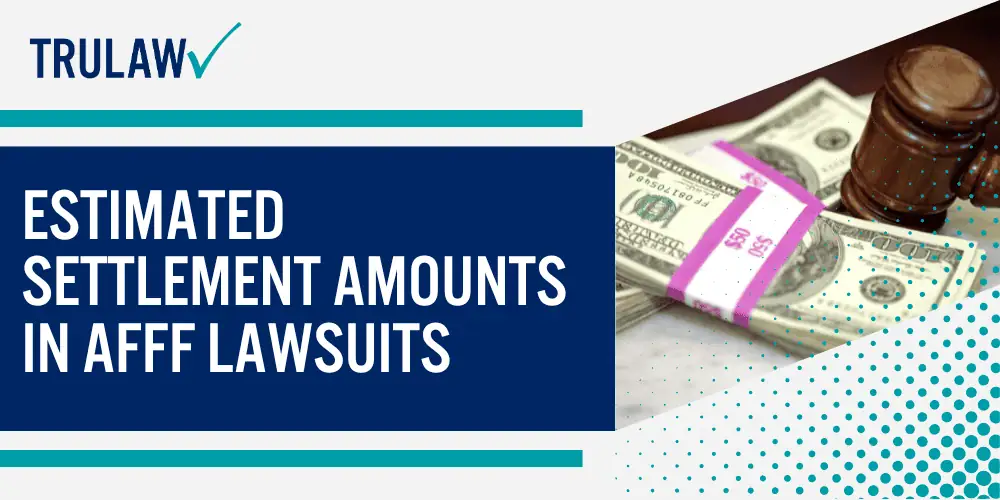
Estimates for potential AFFF lawsuit settlements range from $20,000 to $600,000 (or more), but these figures are speculative and based on outcomes from previous mass tort cases.
It’s important to note that these projections are not guarantees.
The final settlement amounts will depend on the unique circumstances of each case and the strength of the evidence presented.
For updates on the potential settlements, you can visit this page.
Working with AFFF lawyers who have experience in AFFF litigation can provide valuable insights and help build a stronger case.
They can assist with gathering evidence and explain the legal process.
How to File an AFFF Thyroid Cancer Lawsuit
The AFFF Firefighting Foam MDL was created to streamline and manage the growing number of cases related to these personal injury claims.
The AFFF lawyers at TruLaw and our partner law firms are currently accepting clients across the United States who may have been affected by AFFF firefighting foam exposure.
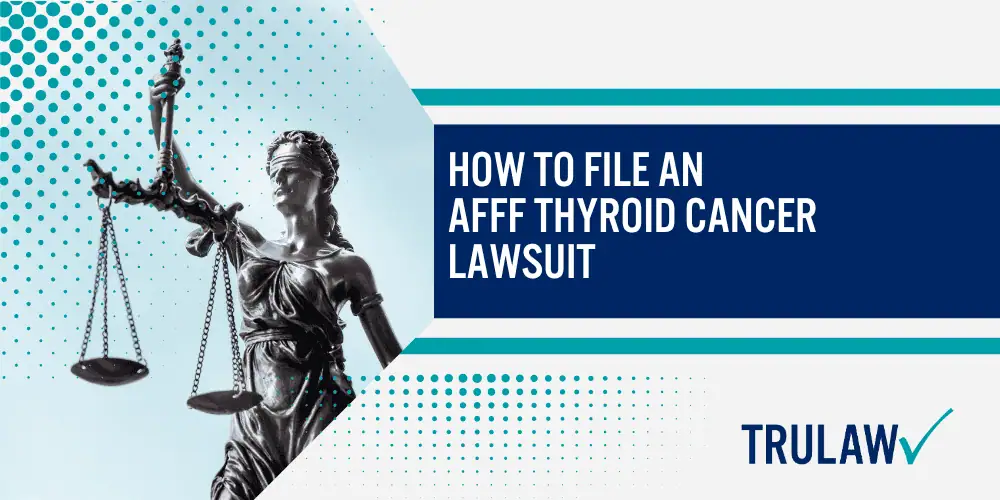
If you or a loved one were exposed to AFFF firefighting foam and have been diagnosed with thyroid cancer, you may be eligible to pursue legal action.
You can use the chatbot on this page to see if you qualify for an AFFF lawsuit instantly.
It’s important to note that TruLaw is only accepting clients with AFFF personal injury claims — we are not accepting clients for the AFFF municipal water contamination lawsuits.
Collecting Evidence for AFFF Firefighting Foam Lawsuits
If you believe your thyroid cancer is linked to exposure to AFFF, gathering the right evidence is an important step in building your case.
While you can start collecting some of this information on your own, working with attorneys experienced in AFFF lawsuits can greatly assist in this process.
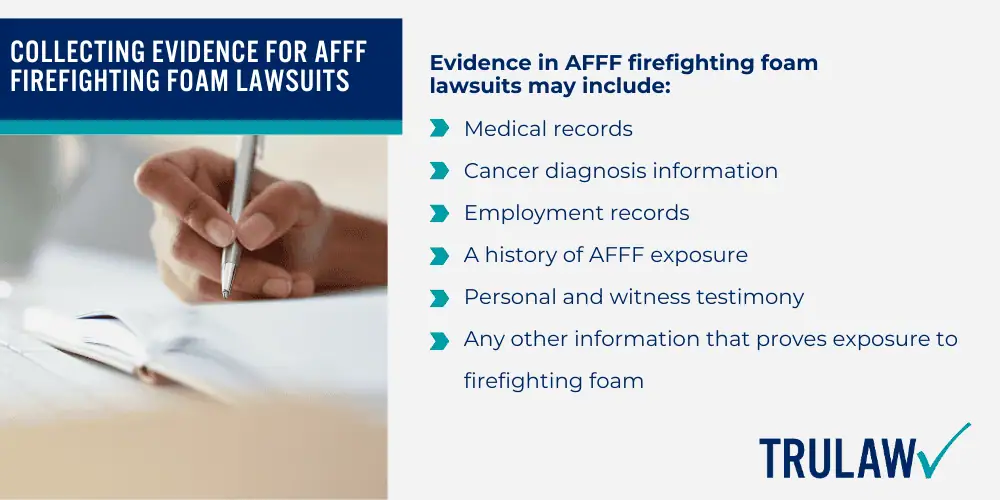
Evidence in AFFF firefighting foam lawsuits may include:
- Medical records
- Cancer diagnosis information
- Employment records
- A history of AFFF exposure
- Personal and witness testimony
- Any other information that proves exposure to firefighting foam
Compensation for Damages in Firefighting Foam Lawsuits
Compensation for damages encompasses the total losses incurred due to exposure to the hazardous PFAS chemicals present in AFFF.
Legal professionals can help assess the impact of these damages and ensure that all relevant factors are considered.
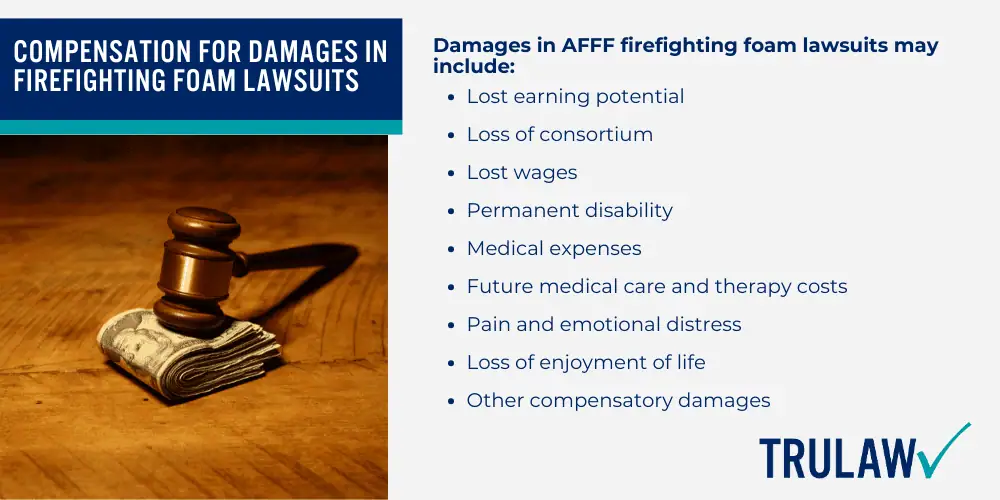
Damages in AFFF firefighting foam lawsuits may include:
- Lost earning potential
- Loss of consortium
- Lost wages
- Permanent disability
- Medical expenses
- Future medical care and therapy costs
- Pain and emotional distress
- Loss of enjoyment of life
- Other compensatory damages
The Importance of Experienced Legal Representation in AFFF Claims
Filing an AFFF thyroid disease lawsuit can be challenging, especially if it involves health issues like thyroid cancer.
Having knowledgeable attorneys who are familiar with these cases is helpful.
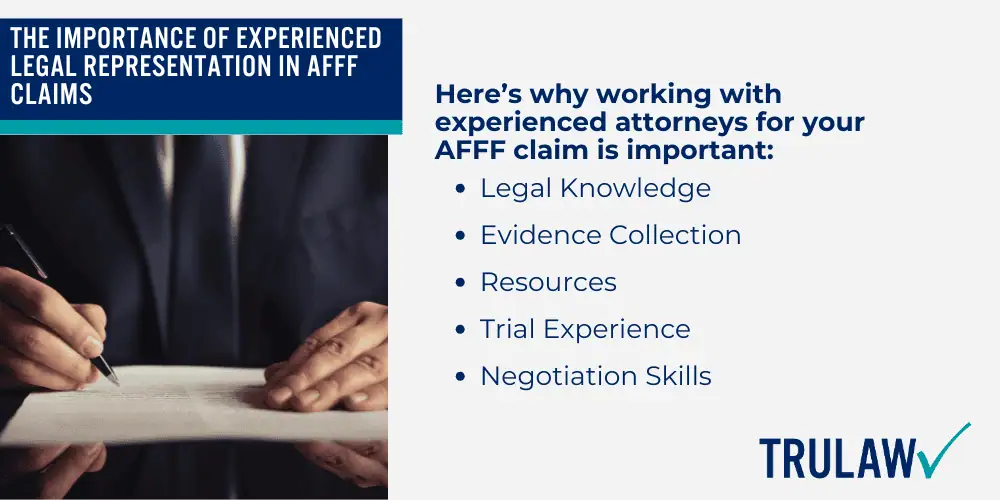
Here’s why working with experienced attorneys for your AFFF claim is important:
- Legal Knowledge: Attorneys familiar with AFFF cases have a deep understanding of the laws, regulations, and precedents that can affect the outcome.
- Evidence Collection: They know exactly what kind of evidence is needed to build a strong case and can assist in gathering it.
- Resources: Working with attorneys who specialize in AFFF lawsuits can give you access to valuable resources and experts that can support your claim.
- Trial Experience: If your case goes to trial, having experienced trial lawyers can make a material difference in presenting your case to a judge or jury.
- Negotiation Skills: Skilled attorneys can negotiate with manufacturers and other defendants to pursue fair compensation.
TruLaw: Your Firefighting Foam Cancer Law Firm
The experienced firefighting foam lawyers at TruLaw and our partner law firms seek to help individuals file claims if they have been impacted by the effects of AFFF exposure.
We are experienced in holding corporations and chemical manufacturers accountable for the harm caused by PFAS chemicals.
If you or a loved one has developed cancer or experienced other health issues after regular exposure to AFFF firefighting foam, you may qualify to file an AFFF lawsuit and seek financial compensation.
Contact us today for more information by using the chatbot on this page to instantly see if you qualify to file an AFFF lawsuit.
If you have questions about the AFFF lawsuit process or the health risks related to firefighting foam, we are here to assist you.
AFFF Lawsuit Frequently Asked Questions
-
Thyroid cancer may not always present noticeable symptoms in its early stages, but some signs to be aware of include:
- Lump or nodule in the neck: A common early sign is a painless lump or nodule in the thyroid gland, located at the front of the neck.
- Swollen lymph nodes: Enlarged lymph nodes in the neck can sometimes indicate that the cancer has spread beyond the thyroid.
- Hoarseness or voice changes: When thyroid nodules press against the vocal cords, they can cause noticeable changes in your voice.
- Difficulty swallowing or breathing: Larger nodules or tumors may interfere with swallowing or breathing as they grow.
-
In an AFFF firefighting foam lawsuit, several factors contribute to determining a settlement amount, such as documented exposure to AFFF, medical records, and proof of related health issues.
Although no settlements have been reached in the AFFF litigation yet, attorneys estimate that settlement amounts may range between $20,000 and $600,000 (or more) depending on the case’s details and strength.
These figures are not guaranteed but are projections based on prior cases involving toxic exposure and cancer diagnoses.
For more personalized information, use the chat on this page to connect with the experienced firefighting foam lawyers at TruLaw and our partner law firms — we can help you understand what to expect for your unique case.
-
AFFF foams that contain PFAS are not completely banned in all areas, but many regions have begun to phase out or restrict their use due to environmental contamination and health concerns.
The US military, for example, has stopped using AFFF containing PFAS and is currently seeking alternatives for its firefighting needs.
Regulations on AFFF foam can vary depending on the country or region, and ongoing developments may impact its availability and usage.
Be sure to check local regulations and the latest updates to determine whether AFFF foam is restricted or banned in your area.
-
No, there is not an AFFF firefighting foam class action lawsuit.
The AFFF cases are consolidated into an MDL, which is different from a class action.
Some law firms will refer to this as the AFFF class action MDL — this is incorrect.
In an MDL, each plaintiff’s case is handled individually, with compensation determined by the specifics of each case.
This allows for a more personalized approach compared to class actions, where settlements are distributed evenly among all plaintiffs.

Managing Attorney & Owner
With over 25 years of legal experience, Jessica Paluch-Hoerman is an Illinois lawyer, a CPA, and a mother of three. She spent the first decade of her career working as an international tax attorney at Deloitte.
In 2009, Jessie co-founded her own law firm with her husband – which has scaled to over 30 employees since its conception.
In 2016, Jessie founded TruLaw, which allows her to collaborate with attorneys and legal experts across the United States on a daily basis. This hypervaluable network of experts is what enables her to share the most reliable, accurate, and up-to-date legal information with our readers!
Additional AFFF Lawsuit resources on our website:
Here, at TruLaw, we’re committed to helping victims get the justice they deserve.
Alongside our partner law firms, we have successfully collected over $3 Billion in verdicts and settlements on behalf of injured individuals.
Would you like our help?
At TruLaw, we fiercely combat corporations that endanger individuals’ well-being. If you’ve suffered injuries and believe these well-funded entities should be held accountable, we’re here for you.
With TruLaw, you gain access to successful and seasoned lawyers who maximize your chances of success. Our lawyers invest in you—they do not receive a dime until your lawsuit reaches a successful resolution!
AFFF Lawsuit claims are being filed against manufacturers of aqueous film-forming foam (AFFF), commonly used in firefighting.
Claims allege that companies such as 3M, DuPont, and Tyco Fire Products failed to adequately warn users about the potential dangers of AFFF exposure — including increased risks of various cancers and diseases.
Depo Provera Lawsuit claims are being filed by individuals who allege they developed meningioma (a type of brain tumor) after receiving Depo-Provera birth control injections.
A 2024 study found that women using Depo-Provera for at least 1 year are five times more likely to develop meningioma brain tumors compared to those not using the drug.
Suboxone Tooth Decay Lawsuit claims are being filed against Indivior, the manufacturer of Suboxone, a medication used to treat opioid addiction.
Claims allege that Indivior failed to adequately warn users about the potential dangers of severe tooth decay and dental injuries associated with Suboxone’s sublingual film version.
Social Media Harm Lawsuits are being filed against social media companies for allegedly causing mental health issues in children and teens.
Claims allege that companies like Meta, Google, ByteDance, and Snap designed addictive platforms that led to anxiety, depression, and other mental health issues without adequately warning users or parents.
Transvaginal Mesh Lawsuits are being filed against manufacturers of transvaginal mesh products used to treat pelvic organ prolapse (POP) and stress urinary incontinence (SUI).
Claims allege that companies like Ethicon, C.R. Bard, and Boston Scientific failed to adequately warn about potential dangers — including erosion, pain, and infection.
Bair Hugger Warming Blanket Lawsuits involve claims against 3M — alleging their surgical warming blankets caused severe infections and complications (particularly in hip and knee replacement surgeries).
Plaintiffs claim 3M failed to warn about potential risks — despite knowing about increased risk of deep joint infections since 2011.
Baby Formula NEC Lawsuit claims are being filed against manufacturers of cow’s milk-based baby formula products.
Claims allege that companies like Abbott Laboratories (Similac) and Mead Johnson & Company (Enfamil) failed to warn about the increased risk of necrotizing enterocolitis (NEC) in premature infants.
Here, at TruLaw, we’re committed to helping victims get the justice they deserve.
Alongside our partner law firms, we have successfully collected over $3 Billion in verdicts and settlements on behalf of injured individuals.
Would you like our help?
